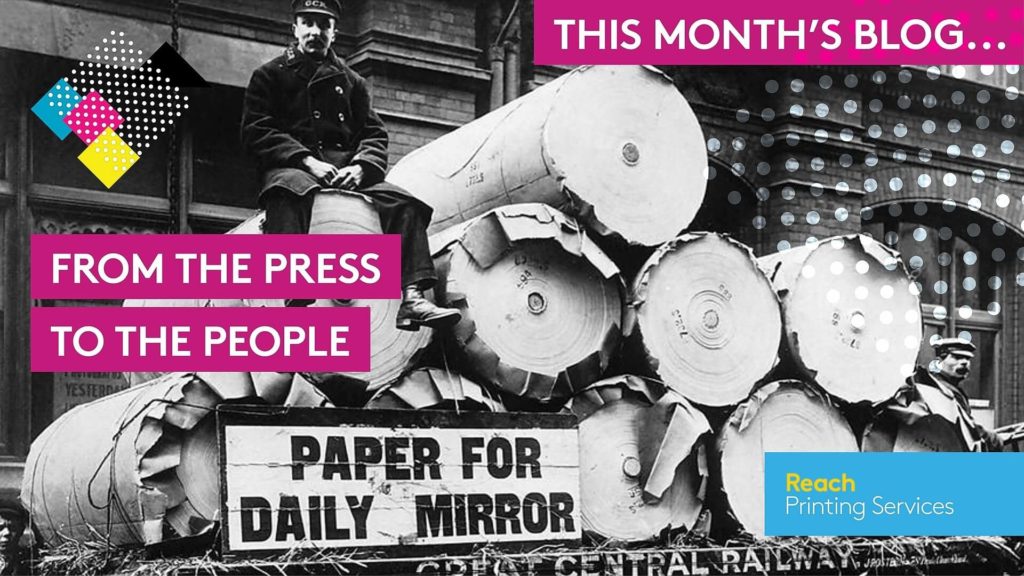
Do you know your pagination from your press-run, or your Pantone from your CMYK?
If not, then you aren’t alone! Since the first printed books rolled off the Gutenberg press in the 15th Century, the print industry has developed a wide range of specialist terminology which can seem like a foreign language to the uninitiated.
Workers at Reach Printing’s first press in 1832, where our inaugural title was the Newcastle Journal, would have heard words and phrases relating to techniques that are still recognisable in the business today – such as, lithography, embossing and etching – as well as many that are now redundant. It was a time of historic change and progression, with the lexicon expanding to reflect this.
200 years of publishing.
The 19th Century was an exciting and groundbreaking time for printing, with a huge increase in productivity due to improvements in the construction of presses and more widespread use of steam in manufacturing and machinery. This allowed for more efficiency, leading to a wider distribution of publications, including books and newspapers. Combined with innovation in the papermaking industry, leading to mass production of paper at less cost, printing presses started rolling at a faster pace than ever – and they’ve never stopped!
Publishers had the opportunity to reach wider audiences than ever before, proving the power of print in an exciting new world. Uniquely, for the first time in history, everybody from elite high society to the poor had access to information – and with it came a new understanding of the power of being able to speak to ordinary people to keep them informed about the issues of the day.
The power of print is timeless – and through the wide range of publications that we print, it is reaching a more diverse audience than ever.
Reach Printing believes in the enduring importance of print in today’s world, just as our predecessors did 200 years ago.
Most people will know of our daily titles like The Mirror, the Daily Express or the Manchester Evening News, did you know we’re also experts in printing niche publications and contract titles, such as The Jewish Weekly and Lush Times?
Whether a direct or contract print publication, we treat every client with the same passion and dedication, and provide the same dedicated service as we did when the first press rolled almost 200 years ago. From initial enquiry through to holding your publication in your hand, the team at Reach will guide you through all the options for your project and make sure you get the very best spec for your needs.
Take a look through our glossary of usefully print terminology to get you started:
Blanket: On a lithography printing press, the interior cylinder used for printing is covered by a rubber blanket. It’s used to transfer the images and text onto the paper.
Bleed: After paper has been printed, the inks may run over the trim marks of the paper. This is known as ‘bleeding.’
CMYK: Cyan, Magenta, Yellow, Black (key) subtractive primary colours – used as the fundamental colours in the printing industry.
Colour Bars: A test strip that’s printed on the waste portion of a press sheet. It helps to monitor and control the quality of the printed material relative to ink density, registration and dot gain.
Densitometer: A device for measuring the colour density at a specific location on a printed product, either by reflected or transmitted light.
Hickey: Spot or imperfection in printing, most visible in areas of heavy ink coverage, caused by dirt on the plate or blanket. Also called bulls eye and fish eye.
Ink Set-Off: Ink that is unintentionally transferred from a printed sheet to the back of the sheet above it when the materials have been printed and are stacked in a pile.
Makeready: In printing, all work done to set up a press for printing.
Off stone: Is the moment at which an edition of a newspaper is finalised for printing and no further changes can be made. “Off stone” comes a short time after the final deadline for submission of images or articles for editing. The term comes from the early days of printing when an imposing stone, a slab of stone or metal on which the type was set into a layout (or forme), was used to align the text.
Offset: A printing method in which the plate transfers the image to be printed onto an intermediate surface called a blanket, which then comes into direct contact with the paper.
Pagination: The process by which a newspaper is laid out or paged.
Pantone: Pantone, Pantone Matching System and PMS + are Pantone Inc’s check-standard trademarks for colour standards, colour data, colour reproduction and colour reproduction materials, and other colour related products and services, meeting its specifications, control and quality requirements. Essentially, refer to a pantone colour name/code and everyone knows precisely which colour you mean.
Pre-Press: All procedures associated with bringing a job to press.
Press Proofs: In colour reproduction, a proof of a colour subject made on a printing press, in advance of the production run.
Press Run: Total number of copies printed.
Print Order: Total number of copies ordered by the client.
Reel: Term used for continuous roll of printing paper
Reel Width: Side to side dimension for a reel of paper
Splice: A seam resulting from the joining of two portions of a paper roll
Tolerances: The specification of acceptable variations in register, density, dot size, plate or paper thickness, concentration of chemicals and other printing parameters
Web Break: The breaking of a paper web when it’s on press. It can be caused by many factors.
Considering a move to a new print supplier? Find out more here
SOURCES:
The British Library (www.bl.uk)
The Metropolitan Museum of Art (www.metmuseum.org)

